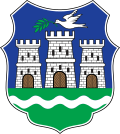| Slovak Evangelical Church | |
|---|---|
Slovenská evanjelická cirkva Словачка евангеличка црква Slovačka evangelička crkva | |
 The church building | |
 | |
| Country | |
| Language(s) | Slovak language |
| Denomination | Lutheranism |
| Architecture | |
| Functional status | active |
The Slovak Evangelical Church in Novi Sad in Vojvodina, Serbia, is a Lutheran church built in 1886 in a baroque-neoclassical style under the patronage of Count Adolf Rajzer. [1] [2] The architectural style of the church is characterized by an eclectic combination of styles from the second half of the 19th century. [1] Although the church suffered some damage during World War II, it has retained its original appearance. [1]
